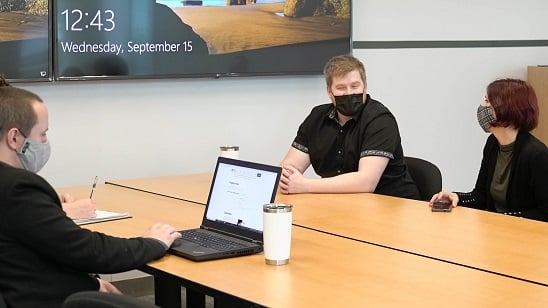
For many businesses, hybrid teams are the future. They’re flexible enough to let your team work in the office some of the time, while working in locations of their choosing the rest of the time – may be their own homes, a coffee shop and even another country. In fact, 66% of business decision-makers are considering redesigning physical spaces to better accommodate hybrid work environments.
But with greater freedom comes greater responsibility. In other words, how do you stay on top of time management with a hybrid team? How do you ensure that each team member—wherever they’re working—is able to stay on track with projects?
It’s a tricky challenge and it’s just one of the challenges that hybrid teams present. And while your usual time management strategy will still work, you’ll need to make adjustments and add new ideas.
In this article, we’ll be taking a look at exactly how you can stay on top of time management with a hybrid workforce—so that projects continue to flow, deadlines are met—wherever your team happens to be working.
Let’s dive in.
Would a Hybrid Model Work For Your Team?
A lot of businesses might worry that, because a hybrid workforce model means their team spends only some of their working life in the office, productivity might suffer.
The argument is that since managers can see and interact with staff when they’re in the office, they will hold them accountable. And this in turn will naturally create an environment that ensures more tasks are completed.
But are staff really making the most of their time when in the office?
It’s an important question because research has shown that the average “eight-hour” worker is productive for less than 3 hours a day.
Instead, too much time is wasted on:
- Checking social media – 47%
- Reading news websites – 45%
- Discussing out-of-work activities with colleagues – 38%
- Making hot drinks – 31%
- Smoking breaks – 28%
- Text/instant messaging – 27%
- Eating snacks – 25%
- Making food in the office – 24%
- Making calls to partners/friends- 24%
- Searching for new jobs – 19%
This means that, despite our best intentions, we don’t always get the best out of our team when they’re in the office – and we certainly don’t impose the best time management practices.
Naturally, you don’t want to be an overbearing boss who watches their team like a hawk. Ultimately, as best you can, try to minimize distractions, keep things like team meetings brief, and more.

What Workplace Model do your Employees Want?
Some workers prefer the hybrid work model. Some prefer working from home 100%. And some prefer working in the office full-time.
Moreover, there are different sectors that are simply better suited to working from home or working in the office. For example, a copywriter and an editor may be able to work perfectly fine online and stay on top of time management practices, but it might be that another department needs to work side-by-side in order to stay on top of things.
However, research has shown that if you do require your workforce to go back to the office full-time, you could lose up to 39% of them. This is likely because a hybrid workplace reduces fatigue by 44%. It also increases intent to stay by 45% and boosts performance by 28%.
Therefore it’s really important that you understand this and create a hybrid model that works for everyone and stays on top of time management. Here’s how:
Find Ways to Increase Productivity
All teams should be looking at ways to increase productivity. Being more productive means we get more work done—individually and collectively.
Of course, boosting the productivity of a hybrid team isn’t a simple task, especially if this type of workforce model is completely new to your business. But it’s really important that you make amendments as you go along, which means keeping a close eye on your KPIs so that you can see what’s working and what isn’t, and what can be improved.
Here are a few KPI’s you could monitor:
- Self-discipline
- Measure for equitable device performance
- Communication effectiveness
- Employee satisfaction
- Bottomline output
As you go along and monitor, assess and analyze, you’ll likely come up with your own ideas on how to better manage your team’s time and productivity. But here are some to help get you started:
- Make sure that whenever someone is working remotely they have access to good, consistent WiFi
- Optimize in-office working conditions (decorate with plants etc)
- Block time for things like emails and calls
- Reduce the number of meetings needed
- Train your staff so that they’re able to work faster in the future
- Keep your team engaged and motivated by organizing a challenge. For example, to design a t-shirt for the whole team and then print the winning design.
That said, it’s also really important that you take the time to measure your team’s productivity too. Measuring a hybrid team’s productivity doesn’t have to be the challenge that it sounds. In fact, you can use the same metrics as you normally would:
- Number of sales
- Goals met (the higher the goals that are met, the more productive your team has been)
- Amount of work completed
- Quality of the work completed
Use The Right Tools
A hybrid workforce model simply won’t work if you aren’t using the right tools. There are all kinds of tools you can use to improve communication, efficiency, productivity, and ultimately time management.
For example, you can implement an in-app chat that allows your team to talk and exchange ideas in real time, a project management tool that ensures everyone knows exactly what is expected of them on a daily basis, and a time management tool that allows your team to become more productive by focusing more on what needs to be done and a lot less on what is only going to distract them.
All these tools, then, will improve your workflow, but it’s really important that you choose tools that work for everyone. Then, make sure your whole team understands how to use the tool (nail the onboarding process) so that engagement with each tool is high.
How to choose the tools that are right for you?
The tools need to have ease of integration, ease of use and ideally they’ll be scalable. They should also allow for customization to suit your needs, but it’s super important to understand that you don’t need a tool for everything.
Final Thoughts
Time management is one of the bedrock of success for any successful business. Because a hybrid team splits the workforce between different locations, it’s naturally going to be tougher to get to grips with managing your team’s time.
But by implementing processes, restructuring your team and using the right tools, you can improve your time management and stay on top of projects while maintaining a high morale. It should be a fluid process, though, and if something isn’t working, make adjustments and move forward.